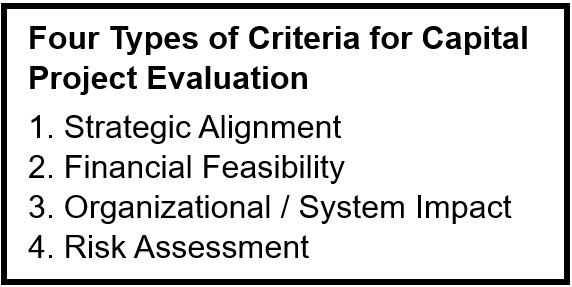Capital Part 6: Implementation (It’s all in the Details)

Margins, and the capital investment pools they enable, are gradually recovering for some organizations. For most though, these funds are still scarce, so capital investments must be selected more carefully than ever. In this series we've been describing evaluation criteria that can be used to select the best investment opportunities. In this post, we focus on implementation and project management.
 We suggest that there are four major types of criteria, each of which were addressed in previous posts in this series (see sidebar). If the selection criteria deserve extra scrutiny in an era of tight capital, then it stands to reason that implementation and project management also need added focus. And at that stage, it’s all about the details, especially these five.
We suggest that there are four major types of criteria, each of which were addressed in previous posts in this series (see sidebar). If the selection criteria deserve extra scrutiny in an era of tight capital, then it stands to reason that implementation and project management also need added focus. And at that stage, it’s all about the details, especially these five.
1. Certificate of Need Health care investments are regulated in many states by certificate of need laws. 35 states have these laws and three more have variants. In Michigan, for example, many types of facility acquisitions and capital expenditures require state approval for investments of $4,250,000 or more. Other nonprofits may have similar standards to consider. Knowing the laws, requirements, and/or standards to comply with is a detail you can’t afford to miss.
2. Process Flow Often capital investments are made to accommodate growth for services that claim to be “running out of space”. Process Flow Mapping can be a critical step to uncover the root cause of inefficient operations and can mitigate unnecessary capital investment. If additional space is a necessary part of the solution, it is important to map how the space will be used before designing it. Process Flow Mapping with front line staff can identify Critical Paths, where consideration of all required steps, hand-offs, and dependencies can expose vulnerabilities as well as points of emphasis in training before a project “goes live”. Even if the project is simply an additional location of an existing service, make sure all personnel are trained in all the relevant procedures, and those procedures have been adjusted as needed to accommodate any differences with the new space.
3. Key Dependencies Along those same lines, it is important to identify key dependencies related to physical assets, personnel and supplies. If helpful, think of these as supply chain vulnerabilities; recall how the Covid19 pandemic clarified how important those are. Does the project require a specialized team member, supply, or piece of equipment? What are the contingency plans if someone, or something, is suddenly unavailable. Have alternative sources been identified?
4. Contingency Planning Dependencies and vulnerabilities warrant contingency planning, and the Process Decision Program Chart (PDPC) is a great tool. We reviewed the PDPC previously in Part 5: Risk Assessment, the fourth and final major project selection criteria. Upstream in project selection, it provides evidence that the proponent(s) have already considered possible failure points and counter measures, further minimizing the risk associated with the project. And now, during Implementation Planning, any PDPC work already prepared should be reviewed and updated if needed. If one hasn’t been created yet, we definitely recommend doing so at this point.
5. Pilots and Trials Lastly, in many cases, a limited scale test run is very doable and can be extremely helpful in implementation planning. In preparing for a pilot or trial, take time to carefully define the scope and duration, as well as the success measure(s), procedures, training, and thorough debriefing. The lessons learned and critical success factors identified can lead to important process refinements. Attention to detail with pilots or trials will lead to smoother, trouble-free full-scale implementations.
Most of these implementation “details” are considered Project Management best practices. Other important steps include the composition of, and support given to the Implementation Team. Determine the key areas of expertise needed and if it will be needed throughout implementation (core team members) or at specific phases (ad hoc members). Will they need any resources, and how often should they meet? The answers to these and other questions will be a function of the nature and scope of each approved project, however the most successful teams have the necessary expertise and resources to guide the implementation from beginning to end. This includes basic project management skills, which can be leveraged either through relevant expertise among one or more team members or a facilitator skilled in project management. It is common for large, complex projects to have an assigned facilitator with project management certification.
Final Thoughts We have covered all four key Selection Criteria and now some key details of Best Practice Implementation. At this point the likelihood of success is near optimum. There are just a few remaining concepts for consideration which we will address next time in our last segment.

 As the calendar draws to a close it's a great time to look forward by looking back. What do I mean? You can use data from past performance to identify opportunities for future improvement. And none of this requires a lot of time, which probably sounds especially good during this holiday-infused, busy time of year. Let's take a closer look at several ways to “pay it forward” with your data.
As the calendar draws to a close it's a great time to look forward by looking back. What do I mean? You can use data from past performance to identify opportunities for future improvement. And none of this requires a lot of time, which probably sounds especially good during this holiday-infused, busy time of year. Let's take a closer look at several ways to “pay it forward” with your data.